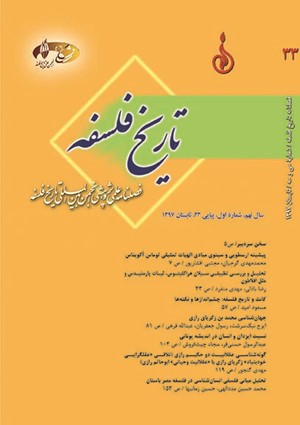تحليل و بررسي تطبيقي سيلان هراکليتوس، ثبات پارمنيدس و مثل افلاطون
محورهای موضوعی : اندیشههای حکمی و فلسفی ایران باستان
1 - دانشگاه قم
2 - دانشگاه قم
کلید واژه: هراکليتوس پارمنيدس افلاطون سيلان هستي ثابت نظريه مُثُل ,
چکیده مقاله :
وجودشناسي و مسئله هستي اصيل و غيراصيل از يونان باستان تاکنون همواره مورد بحث و بررسي فلاسفه بوده است. در ميان فلاسفه يونان، هراکليتوس، پارمنيدس و افلاطون بجهت نظريات خاصشان از اهميت خاصي برخوردارند. هراکليتوس معتقد به سيلان و تغيير دائم اشياء بود و منکر ثبات در هستي، اما پارمنيدس برخلاف او، منکر تغيير و معتقد به ثبات و تغييرناپذيري هستي بود. اين دو نظريه متضاد در نظريه مُثُل افلاطون تبلور و ظهور پيدا کرد و او با بهره مندي از آن دو نظريه و بکارگيري سيلان دائم هراکليتوس در جهان محسوسات و ثبات هستي پارمنيدس در عالم مُثُل، نظريه اختصاصي خود را سامان داد. نوشتار حاضر مسئله وجود را از منظر اين سه فيلسوف، مورد بررسي تطبيقي قرار داده تا هم سويي افلاطون با دو فيلسوف سلف خود را روشن و تبيين سازد. با تطبيق وجودشناسي اين سه فيلسوف يوناني، روشن شد که ميتوان نظريه ثبات پارمنيدس (راه حقيقت) و نظريه وحدت هراکليتوس را با عالم مُثُل افلاطون تطبيق داد و نظريه سيلان هراکليتوس و راه گمان پارمنيدس با جهان محسوسات افلاطون، هم سويي و قرابت دارند.
The issue of ontology and the problem of authentic and unauthentic types of being have always been debated by philosophers since the time of ancient Greece until now. Among Greek philosophers, Heraclitus, Parmenides, and Plato enjoy particular significance because of their particular theories. Heraclitus believed in flux and everlasting change of things and denied stability in being. By contrast, Parmenides denied change and believed in stability and unchangability in being. These two opposite theories were later reformulated in Plato’s theory of Ideas. He developed his particular theory by benefitting from these two theories and employed Heraclitus’ continuous flux in the world of sensibles and Parmenides’ stability of being in the world of Ideas. The present paper comparatively examines the problem of existence from the viewpoint of these three philosophers in order to clarify Plato’s agreement with his two predecessors. A comparison of the ontological views of these three Greek philosophers revealed that Parmenides’ theory of stability (way of truth) and Heraclitus’ theory of unity can be matched with Plato’s world of Ideas. Moreover, the writers conclude that Heraclitus’ theory of flux and Parmenides’ ways of inquiry are compatible with Plato’s world of sensibles.
استيس، والتر ترنس، تاريخ انتقادي فلسفه يونان، ترجمه يوسف شاقول، قم، دانشگاه مفيد، چ2، 1386.
افلاطون، دوره آثار، ترجمه محمدحسن لطفي، تهران، انتشارات خوارزمي، 1357.
بريه، اميل، تاريخ فلسفه، ترجمه عليمراد داودي، تهران، مرکز نشردانشگاهي، ج1، چ2، 1374.
بورمان، کارل، افلاطون، ترجمه محمدحسن لطفي، تهران، انتشارات طرح نو، چ2، 1387.
تسلر، ادوارد، کليات تاريخ فلسفه يونان، ترجمه حسن فتحي، تهران، انتشارات حکمت، چ1، 1395.
خامنهاي، سيدمحمد، سير حكمت در ايران و جهان، تهران، انتشارات بنياد حكمت اسلامي صدرا، 1380.
خراساني، شرفالدين، از سقراط تا ارسطو، تهران، انتشارات دانشگاه شهيد بهشتي، چ2، 1393.
خراساني، شرفالدين، نخستين فيلسوفان يونان، تهران، شرکت سهامي کتابهاي جيبي، چ2، 1357.
ديل، هالينگ، مباني و تاريخ فلسفه غرب، ترجمه عبدالحسين آذرنگ، تهران، انتشارات کيهان، چ1، 1364.
کاپلستون، فردريک چارلز، تاريخ فلسفه، ترجمه سيدجلالالدين مجتبوي، تهران، انتشارات علمي و فرهنگي، ج1، چ8، 1388.
گاتري، ويليام کيث چيمبرز، تاريخ فلسفه¬ يونان، ترجمه مهدي قوام صفري، تهران، فکر روز، ج6، چ1، 1376.
گاتري، ويليام کيث چيمبرز، تاريخ فلسفه يونان، ترجمه حسن فتحي، تهران، فکر روز، ج16، چ1، 1377.
گاتري، ويليام کيث چيمبرز، فيلسوفان يونان از طالس تا ارسطو، ترجمه حسن فتحي، تهران، نشر علم، چ2، 1388.
گمپرتس، تئودور، متفکران يوناني، ترجمه محمدحسن لطفي، تهران، انتشارات خوارزمي، چ1، 1375.
وال، ژان، بحث در مابعدالطبيعه، ترجمه يحيي مهدوي، تهران، انتشارات خوارزمي، 1380.
Burnet, John, Early Greek Philosophy, London, Adamant Media Corporation, 1920.
Cornford, F.M., Plato and Parmenides, London, Routledge, 2001.
Palmer, John, Parmenides and Pre-Socratic Philosophy, New York, Oxford University Press, 2009.

